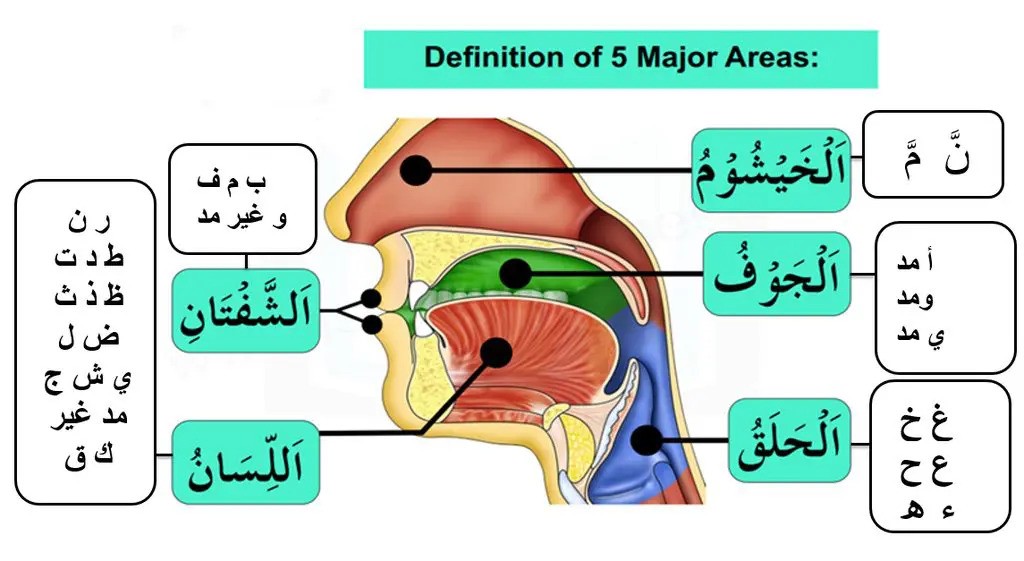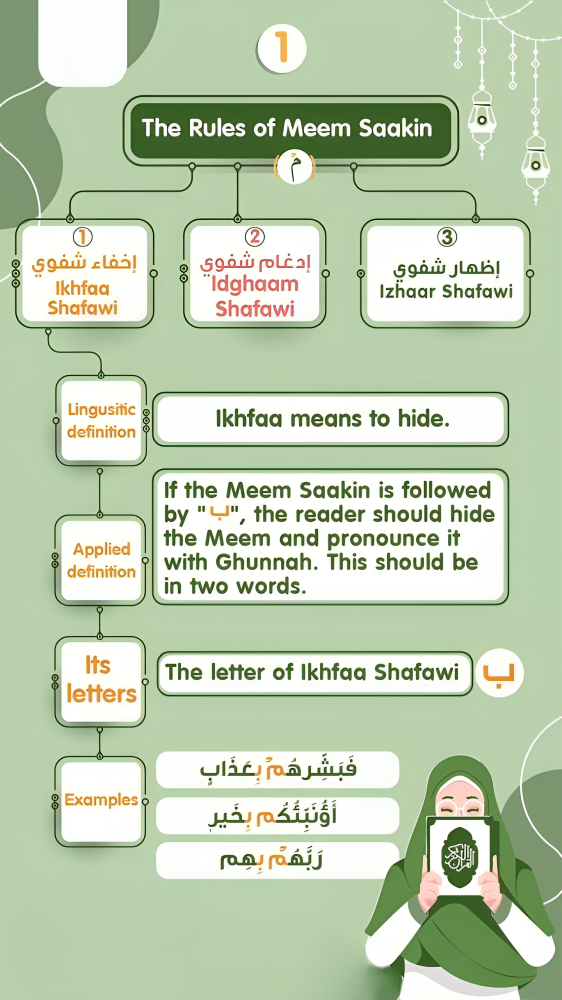The Place of Origin of Arabic Letters
In the study of Tajweed, understanding Makhaarij (the place of origin of Arabic letters) is fundamental. The clarity and precision of Quranic recitation are achieved by learning where each letter originates within the mouth, throat, and nasal cavity. This knowledge helps preserve the integrity of the Quran’s pronunciation and its beautiful rhythm. In Lesson 4, we explore the 17 Makhaarij that govern the pronunciation of the 29 Arabic letters.
What are Makhaarij?
Makhaarij (مخارج) is the plural of Makhraj (مخرج), which means “place of origin” or “articulation point.” When reciting, each Arabic letter has a specific location in the mouth or throat where its sound originates. The proper knowledge and application of these Makhaarij are crucial for the correct recitation of the Quran. Mastering this skill allows you to clearly pronounce each letter without distorting the meaning of the words.
The Seventeen Makhaarij for the Twenty-Nine Letters
| Makhraj | Letters | Place of Origin |
| 1. Long Vowels (حروف مدہ) | ا (مدہ) | Emptiness of the mouth |
| 2. Guttural Letters (حروف حلقي) | ء، هـ | Back of the throat (near the chest) |
| 3. | ع، ح | Middle of the throat |
| 4. | غ، خ | Front of the throat (near the mouth) |
| 5. Uvula Letters (حروف لهويه) | ق | Back of the tongue, touching the soft palate |
| 6. | ك | Back of the tongue, touching the soft palate closer to the mouth |
| 7. Middle Letters (حروف شجريه) | ج، ش، ي | Middle of the tongue touches the upper palate |
| 8. Side Letter (حافه) | ض | Side of the tongue touches the upper molars |
| 9. Sider Letters (حروف طرفيه) | ل | Front side of the tongue touches the gums of the upper teeth |
| 10. | ن | Front side of the tongue touches the gums of the upper incisor and canine teeth |
| 11. | ر | Front side of the tongue touches the gums of the upper incisor |
| 12. Root Letters (حروف نطعيه) | ط، د، ت | Tip of the tongue touches the root of the upper central incisor |
| 13. Gums Letters (حروف لثويه) | ظ، ذ، ث | Tip of the tongue touches the edge of the upper incisor |
| 14. Whistle Letters (حروف صفير) | ز، س، ص | Tip of the tongue touches the edge of the lower central incisor and lightly touches the upper central incisor |
| 15. Lips Letters (حروف شفويه) | ف | Inner part of the bottom lip touches the edge of the upper teeth |
| 16. | ب، م، و | Lips meeting at different points: moist part for Ba (ب), dry part for Meem (م), and partially for Wow (و) |
| 17. Nasal Letters (خيشومى) | ن، م (غنه) | Nasal cavity for the nasal sound (غنه) |
Why Learning Makhaarij is Essential
The Quran is a divine text, and every word is filled with wisdom. Mispronouncing even a single letter could change the meaning of a word entirely. For example, the difference between the letters “س” (seen) and “ص” (saad) may seem small, but in Arabic, they hold distinct meanings and pronunciations. This is why correct articulation through mastering the Makhaarij is so important for Quranic recitation.
By studying the Makhaarij, we honor the precision and eloquence of the Arabic language and maintain the sanctity of the Quran’s message. Whether you are a beginner or advanced in your Tajweed journey, this lesson will serve as a key foundation for improving your recitation skills.
Types of Ya in Arabic
There are three types of the letter “Ya” (ي) in Arabic script, each with distinct pronunciation rules. These types are important in understanding how the letter functions within a word.
(i) Ya Maddah (ياء مدّة)
- Definition: “Ya Saakin” (يْ) that has a Kasrah (a short vowel representing an ‘i’ sound) before it.
- Example: The word جيد (“Jayyid”) contains a Ya Maddah, where the Kasrah (the short ‘i’) is followed by a silent “Ya” (ي).
(ii) Ya Leen (ياء لين)
- Definition: “Ya Saakin” (يْ) that has a Fathah (a short vowel representing an ‘a’ sound) before it.
- Example: The word ضيف (“Dayf”) contains a Ya Leen, where the Fathah (the short ‘a’) precedes the silent “Ya” (ي).
(iii) Ya Mutaharrik (ياء متحرك)
- Definition: A “Ya” (ي) that carries one of the vowel marks: either a Fathah (َ ), Kasrah (ِ ), or Dammah (ُ).
- Examples: Words like يسري (“Yasri”), عين (“Ayn”), and بيلد (“Baylad”) demonstrate the Ya Mutaharrik, where the “Ya” is accompanied by a vowel.
Important Notes:
- Pronunciation Origins:
- Wow Maddah is pronounced from the first Makhraj (place of articulation in the mouth).
- Wow Leen and Wow Mutaharrik are pronounced from the sixteenth Makhraj.
- Ya Pronunciations:
- Ya Maddah is pronounced from the first Makhraj.
- Ya Leen and Ya Mutaharrik are pronounced from the seventh Makhraj.





